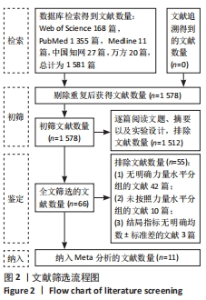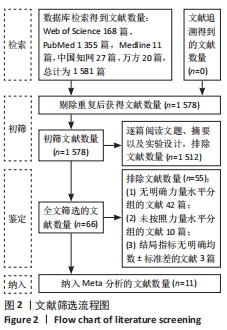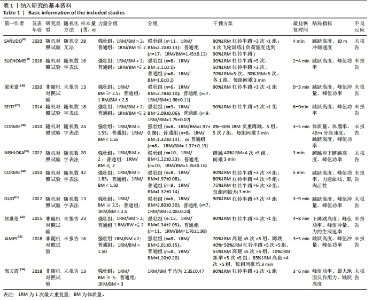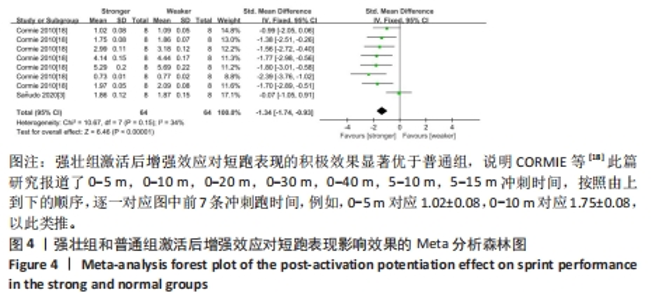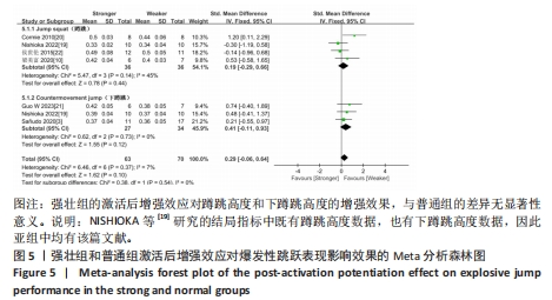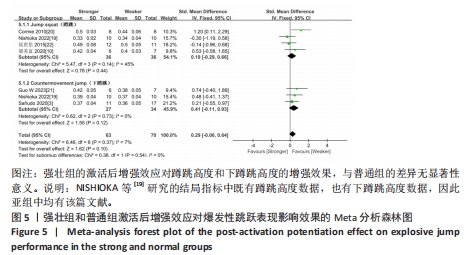Chinese Journal of Tissue Engineering Research ›› 2024, Vol. 28 ›› Issue (28): 4586-4592.doi: 10.12307/2024.468
A meta-analysis of the effect of post-activation potentiation on athletic performance after activation of lower-extremity relative strength levels
Zhang Junjie1, Zhou Wei2, Liu Haiyuan1, Guo Chenggen3
- 1Graduate School, Capital University of Physical Education and Sports, Beijing 100191, China; 2China School of Athletics, Beijing Sport University, Beijing 100084, China; 3Department of Physical Fitness, Wuhan Sports University, Wuhan 430079, Hubei Province, China
-
Received:2023-08-07Accepted:2023-09-05Online:2024-10-08Published:2023-11-27 -
Contact:Liu Haiyuan, PhD, Professor, Doctoral supervisor, Graduate School, Capital University of Physical Education and Sports, Beijing 100191, China Zhou Wei, China School of Athletics, Beijing Sport University, Beijing 100084, China -
About author:Zhang Junjie, PhD candidate, Graduate School, Capital University of Physical Education and Sports, Beijing 100191, China
CLC Number:
Cite this article
Zhang Junjie, Zhou Wei, Liu Haiyuan, Guo Chenggen. A meta-analysis of the effect of post-activation potentiation on athletic performance after activation of lower-extremity relative strength levels[J]. Chinese Journal of Tissue Engineering Research, 2024, 28(28): 4586-4592.
share this article
Add to citation manager EndNote|Reference Manager|ProCite|BibTeX|RefWorks
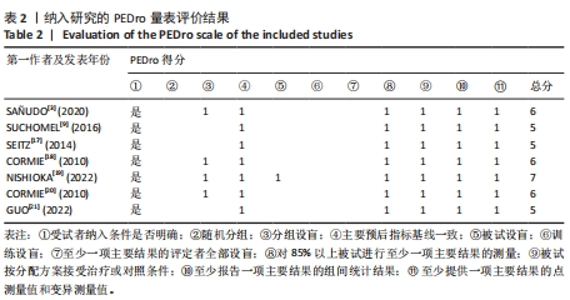
2.2 纳入研究的基本特征与质量评价结果 纳入Meta分析所有的研究均是2010年及以后发表,其中6篇是在过去5年内发表[3,10,19,21,23-24],见表2,3。采用PEDro量表对随机对照试验的文献质量进行评分,其均值为5.71分,总体被纳入研究报告的方法学质量接近较高质量等级。纳入的11篇文献均为运动人体试验干预研究[3,9-10,17-24],其中随机对照试验有7项[3,9,17-21],多数研究未明确是否进行了施盲设置。运动人体科学试验相关研究由于其试验设计自身的局限性,在施盲和扩大样本量方面存在较大的难度,进而可能影响了纳入文献的方法学质量。另外,共纳入4项明确按照下肢1RM/BM的比值为分组标准的非随机对照试验研究[10,22-24],均报道了具体的分组要求和标准。纳入文献均为运动人体试验干预研究,故而意向干预偏离为高偏倚风险,见表3。受试者纳入条件明确,且能够按照试验设计,顺利完成试验干预,测试结果报告均较完整。强壮组和普通组的基线水平均不存在显著性意义(P > 0.05),两组人数均等,被试均衡可比。"
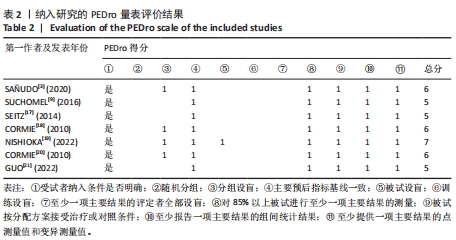
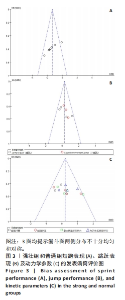
2.3 Meta分析结果 2.3.1 短跑表现发表偏倚评价及其效应量的Meta分析结果 漏斗图结果显示,图形不十分对称,见图3A,Egger 检验未发现纳入研究存在明显的发表偏倚(P=0.195 > 0.1)。有2项研究报道了诱导干预后的短跑冲刺时间变化情况,见图4。Meta分析结果显示,研究间存在无显著性意义的轻度异质性(I2=34%,P=0.15),因此采用固定效应模型将8组关于短跑表现的数据总体效应合并分析,发现合并效应量(SMD)及95%CI为-1.34(-1.74至-0.93),差异存在显著性意义(P < 0.000 01)。森林图显示,短跑时间95%CI落在无效线左侧,即强壮组激活后增强效应对短跑表现的积极效果显著优于普通组。 2.3.2 跳跃表现发表偏倚评价及其效应量的Meta分析结果 漏斗图结果显示,图形不十分对称,见图3B,Egger 检验未发现纳入研究存在明显的发表偏倚(P=0.311 > 0.1)。共有7项研究纳入分析,见图5,有5项研究报道了蹲跳高度(squat Jump,SJ),有2项研究报道了下蹲跳高度(countermovement jump,CMJ),NISHIOKA等[19]的研究报道中既有蹲跳高度也有下蹲跳高度。Meta分析结果显示,研究间存在无显著性意义的轻度异质性(I2=7%,P=0.37),故采用固定效应模型,合并总效应量的95%CI为0.29(-0.06-0.64),差异不存在显著性意义(P=0.10)。对蹲跳高度和下蹲跳高度进行亚组分析,发现蹲跳高度的效应量及95%CI为0.19(-0.29-0.66)、下蹲跳高度的效应量(SMD)及95%CI为0.41(-0.11-0.93)。森林图显示,蹲跳高度95%CI和下蹲跳高度95%CI均与无效线相交,即强壮组的激活后增强效应对蹲跳高度和下蹲跳高度的积极效果,与普通组差异无显著性意义。"
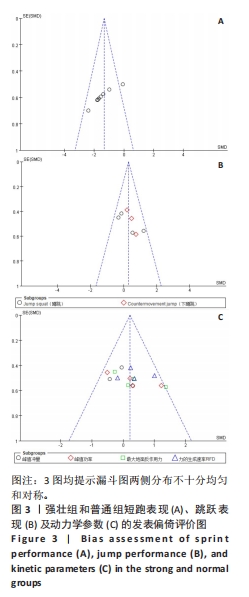

为探索异质性的来源,进一步研究不同下肢相对力量水平被试激活后增强效应对跳跃高度表现合并效应量的影响,因此进行敏感性分析。剔除JAMES等[23]的研究后发现异质性由I2=69%明显降低至I2=45%,P=0.44 > 0.1,进一步分析该篇研究发现,其以16名有力量训练基础的男性大学生运动员作为研究对象,按照1RM/BM > 2为强壮组(2.01±0.15),反之为普通组(1.20±0.20),干预动作模式是负重蹲跳和杠铃半蹲,结局指标是跳跃表现的运动学和动力学参数指标。剔除JAMES等[23]这篇文章后发现,合并效应量及95%CI由0.41(0.08-0.75)降至0.29(-0.06-0.64),结果差异存在显著性意义(P=0.02),故剔除该篇研究,且不纳入合并分析。 2.3.3 动力学参数发表偏倚评价及其效应量的Meta分析结果 漏斗图结果显示,图形不十分对称,见图3C,Egger检验未发现纳入研究存在明显的发表偏倚(P=0.265 > 0.1)。共6项研究纳入分析,见图6。Meta分析结果显示,研究间存在无显著性意义的轻度异质性(I2=15%,P=0.28),采用固定效应模型,得到合并的总效应量(SMD)的95%CI为0.22(-0.03-0.47),差异无显著性意义(P=0.09)。对峰值冲量、峰值功率、最大地面反作用力以及力的生成速率亚组进行组间分析:发现峰值冲量的效应量及95%CI为-0.07(-0.62-0.47)、峰值功率的效应量及95%CI为0.21(-0.29-0.72)、最大地面反作用力的效应量及95%CI为0.31(-0.20-0.81)、力的生成速率的效应量及95%CI为0.36(-0.11-0.82)。森林图显示,峰值冲量95%CI、最大地面反作用力95%CI、力的生成速率95%CI横线均与无效线相交,说明强壮组激活后增强效应对峰值冲量、峰值功率、最大地面反作用力及力的生成速率的增强效果,与普通组的差异不存在显著性意义。"
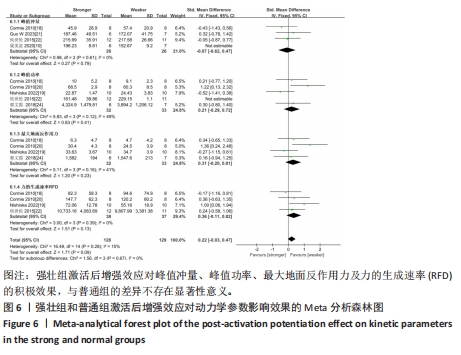
| [1] TILLIN NA, BISHOP D. Factors modulating post-activation potentiation and its effect on performance of subsequent explosive activities. Sports Med. 2009;39(2):147-166. [2] GOŁAŚ A, MASZCZYK A, ZAJAC A, et al. Optimizing post activation potentiation for explosive activities in competitive sports. J Hum Kinet. 2016;52(9):95-106. [3] SAÑUDO B, DE HOYO M, HAFF GG, et al. Influence of strength level on the acute post-activation performance enhancement following flywheel and free weight resistance training. Sensors (Basel). 2020;20(24):7156-7164. [4] AANDAHL HS, VON HEIMBURG E, VAN DEN TILLAAR R. Effect of postactivation potentiation induced by elastic resistance on kinematics and performance in a roundhouse kick of trained martial arts practitioners. J Strength Cond Res. 2018;32(4):990-996. [5] 王安利,张新.力量训练的理论探索及实践进展:后激活增强效应的影响因素及应用[J].中国学校体育(高等教育),2014,1(11):79-83. [6] RUBEN RM, MOLINARI MA, BIBBEE CA, et al. The acute effects of an ascending squat protocol on performance during horizontal plyometric jumps. J Strength Cond Res. 2010;24(2):358-369. [7] GONZÁLEZ-GARCÍA J, LATELLA C, AGUILAR-NAVARRO M, et al. Effects of resistance priming exercise on within-day jumping performance and its relationship with strength level. Int J Sports Med. 2023;44(1):38-47. [8] MCBRIDE JM, DAVIE A. A comparison of strength and power characteristics between power lifters, olympic lifters, and sprinters. J Strength Cond Res. 1999;13(13):58-66. [9] SUCHOMEL TJ, SATO K, DEWEESE BH, et al. Potentiation following ballistic and nonballistic complexes: the effect of strength level. J Strength Cond Res. 2016;30(7):1825-1833. [10] 梁美富,张怀川,张树峰,等.不同力量水平运动员激活后增强效应的时域特征[J].上海体育学院学报,2020, 44(6):54-61. [11] SLOTH M, SLOTH D, OVERGAARD K, et al. Effects of sprint interval training on VO2max and aerobic exercise performance: a systematic review and meta-analysis. Scand J Med Sci Sports. 2013;23(6):e341-e352. [12] 吴旸,李倩,包大鹏.加压力量训练对下肢骨骼肌影响的Meta分析[J].中国体育科技,2019,55(3):20-26. [13] MAHER CG, SHERRINGTON C, HERBERT RD, et al. Reliability of the PEDro scale for rating quality of randomized controlled trials. Phys Ther. 2003;83(8):713-721. [14] STERNE JA, HERNÁN MA, REEVES BC, et al. ROBINS-I: a tool for assessing risk of bias in non-randomised studies of interventions. BMJ. 2016;355:i4919. [15] 刘伊依,邱俊强,衣龙燕,等.接受抗阻训练中老年人白细胞介素6与C-反应蛋白变化的Meta分析[J].中国组织工程研究,2022,26(5):804-812. [16] ENG C, KRAMER CK, ZINMAN B, et al. Glucagon-like peptide-1 receptor agonist and basal insulin combination treatment for the management of type 2 diabetes: a systematic review and meta-analysis. Lancet. 2014;384(9961):2228-2234. [17] SEITZ LB, DE VILLARREAL ES, HAFF GG. The temporal profile of post activation potentiation is related to strength level. J Strength Cond Res. 2014;28(3):706-715. [18] CORMIE P, MCGUIGAN MR, NEWTON RU. Changes in the eccentric phase contribute to improved stretch-shorten cycle performance after training. Med Sci Sports Exerc. 2010;42(9):1731-1744. [19] NISHIOKA T, OKADA J. Influence of strength level on performance enhancement using resistance priming. J Strength Cond Res. 2022;36(1):37-46. [20] CORMIE P, MCGUIGAN MR, NEWTON RU. Influence of strength on magnitude and mechanisms of adaptation to power training. Med Sci Sports Exerc. 2010;42(8):1566-1581. [21] GUO W, LIANG M, LIN J, et al. Time duration of post-activation performance enhancement (PAPE) in elite male sprinters with different strength levels. Children (Basel). 2022;10(1):53-62. [22] 侯世伦,张新,王安利.下肢力量与负荷后恢复时间对后激活增强效应的影响[J].北京体育大学学报,2015, 38(5):57-62. [23] JAMES LP, GREGORY HAFF G, KELLY VG, et al. The impact of strength level on adaptations to combined weightlifting, plyometric, and ballistic training. Scand J Med Sci Sports. 2018;28(5):1494-1505. [24] 郭文霞,曲淑华,孔振兴,等.以时域特征为视角的骨骼肌激活后增强效应[J].中国组织工程研究,2018, 22(24):3804-3810. [25] MANNING DR, STULL JT. Myosin light chain phosphorylation-dephosphorylation in mammalian skeletal muscle. Am J Physiol. 1982;242(3):234-241. [26] VANDERVOORT AA, QUINLAN J, MCCOMAS AJ. Twitch potentiation after voluntary contraction. Exp Neurol. 1983;81(1):141-152. [27] BROWN IE. post activation potentiation a clue for simplifying models of muscle dynamics. American Zoologist. 1998;38(4):743-754. [28] SEITZ LB, HAFF GG. Factors modulating post-activation potentiation of jump, sprint, throw, and upper-body ballistic performances: a systematic review with meta-analysis. Sports Med. 2016;46(2):231-240. [29] WILSON JM, FLANAGAN EP. The role of elastic energy in activities with high force and power requirements: a brief review. J Strength Cond Res. 2008;22(5):1705-1715. [30] JO E, JUDELSON DA, BROWN LE, et al. Influence of recovery duration after a potentiating stimulus on muscular power in recreationally trained individuals. J Strength Cond Res. 2010;24(2):343-347. [31] SEITZ LB, REYES A, TRAN TT, et al. Increases in lower-body strength transfer positively to sprint performance: a systematic review with meta-analysis. Sports Med. 2014; 44(12):1693-1702. [32] COMFORT P, HAIGH A, MATTHEWS MJ. Are changes in maximal squat strength during preseason training reflected in changes in sprint performance in rugby league players? J Strength Cond Res. 2012;26(3):772-776. [33] HARRIS GR, STONE MH, O’BRYANT HS. Short-term performance effects of high power, high force, or combined weight-training methods. J Strength Cond Res. 2000;14(1):14-20. [34] 梁美富,郭文霞,孔振兴,等.激活后增强效应的间歇时间对下蹲跳高度影响的Meta分析[J].武汉体育学院学报,2018,52(2):49-56. [35] GIRMAN JC, JONES MT, MATTHEWS TD, et al. Acute effects of a cluster-set protocol on hormonal, metabolic and performance measures in resistance-trained males. Eur J Sport Sci. 2014;14(2):151-159. [36] ZAMPARO P, MINETTI AE, DI PRAMPERO PE. Interplay among the changes of muscle strength, cross-sectional area and maximal explosive power: theory and facts. Eur J Appl Physiol. 2002;88(3):193-202. [37] ESFORMES JI, BAMPOURAS TM. Effect of back squat depth on lower-body postactivation potentiation. J Strength Cond Res. 2013;27(11):2997-3000. [38] GOURGOULIS V, AGGELOUSSIS N, KASIMATIS P, et al. Effect of a submaximal half-squats warm-up program on vertical jumping ability. J Strength Cond Res. 2003;17(2):342-344. [39] REQUENA B, GAPEYEVA H, GARCÍA I, et al. Twitch potentiation after voluntary versus electrically induced isometric contractions in human knee extensor muscles. Eur J Appl Physiol. 2008;104(3):463-472. [40] SALE DG. Postactivation potentiation: role in human performance. Exerc Sport Sci Rev. 2002;30(3):138-143. [41] GILBERT G, LEES A. Changes in the force development characteristics of muscle following repeated maximum force and power exercise. Ergonomics. 2005;48(11-14): 1576-1584. |
| [1] | Zhong Jun, Wang Wen. Network meta-analysis of different anatomical repair strategies to improve chronic lateral ankle instability [J]. Chinese Journal of Tissue Engineering Research, 2024, 28(9): 1470-1476. |
| [2] | Li Yongjie, Fu Shenyu, Xia Yuan, Zhang Dakuan, Liu Hongju. Correlation of knee extensor muscle strength and spatiotemporal gait parameters with peak knee flexion/adduction moment in female patients with knee osteoarthritis [J]. Chinese Journal of Tissue Engineering Research, 2024, 28(9): 1354-1358. |
| [3] | Shan Jiaxin, Zhang Yilong, Wu Hongtao, Zhang Jiayuan, Li Anan, Liu Wengang, Xu Xuemeng, Zhao Chuanxi. Changes in muscle strength and pain in patients receiving Jianpi Yiqi Huoxue Formula after total knee arthroplasty [J]. Chinese Journal of Tissue Engineering Research, 2024, 28(9): 1378-1382. |
| [4] | Ma Shuwei, He Sheng, Han Bing, Zhang Liaoyun. Exosomes derived from mesenchymal stem cells in treatment of animals with acute liver failure: a meta-analysis [J]. Chinese Journal of Tissue Engineering Research, 2024, 28(7): 1137-1142. |
| [5] | Zhang Zeyi, Yang Yimin, Li Wenyan, Zhang Meizhen. Effect of foot progression angle on lower extremity kinetics of knee osteoarthritis patients of different ages: a systematic review and meta-analysis [J]. Chinese Journal of Tissue Engineering Research, 2024, 28(6): 968-975. |
| [6] | Hu Zhixing, Li Qun, Yang Chao, Wang Xiaoxiao, Fang Luochangting, Hou Wuqiong, Lin Na, Chen Weiheng, Liu Chunfang, Lin Ya. Network meta-analysis of the modeling effects of different factors on rabbit models of steroid-induced osteonecrosis of femoral head [J]. Chinese Journal of Tissue Engineering Research, 2024, 28(6): 976-984. |
| [7] | Yu Zhaoyu, Tan Lixin, Sun Kai, Lu Yao, Li Yong. Meta-analysis of cement-augmented pedicle screw for thoracolumbar degenerative diseases with osteoporosis [J]. Chinese Journal of Tissue Engineering Research, 2024, 28(5): 813-820. |
| [8] | Abuduwupuer·Haibier, Alimujiang·Yusufu, Maihemuti·Yakufu, Maimaitimin·Abulimiti, Tuerhongjiang·Abudurexiti. Meta-analysis of efficacy and safety of terlipatide and bisphosphate in the treatment of postmenopausal osteoporosis fractures [J]. Chinese Journal of Tissue Engineering Research, 2024, 28(4): 639-645. |
| [9] | Bai Xiaotian, Chen Zhaoying, Song Yiling, Wang Ye, Liu Jingmin. Effect of minimalist shoes on foot muscle morphology: systematic evaluation and Meta-analysis [J]. Chinese Journal of Tissue Engineering Research, 2024, 28(4): 646-650. |
| [10] | Wang Juan, Wang Ling, Zuo Huiwu, Zheng Cheng, Wang Guanglan, Chen Peng. Rehabilitative efficacy of kinesio taping following anterior cruciate ligament reconstruction: a Meta-analysis [J]. Chinese Journal of Tissue Engineering Research, 2024, 28(4): 651-656. |
| [11] | Xu Chenghan, Zhuo Hanjie, Chai Xubin, Huang Yong, Zhang Bowen, Chen Qin, Hao Yupeng, Li Lin, Zhou Yingjie. Meta-analysis of the incidence and related factors for cervical spine instability in patients with rheumatoid arthritis [J]. Chinese Journal of Tissue Engineering Research, 2024, 28(24): 3922-3929. |
| [12] | Wang Yuetong, Peng Liang, Su Yuying, Liu Jiajun. Effect of balance training on chronic ankle instability: a meta-analysis [J]. Chinese Journal of Tissue Engineering Research, 2024, 28(24): 3930-3936. |
| [13] | Dong Kuan, Xu Chengli, Tian Jing, Xu Changchun. Effects of endurance training with blood flow restriction on aerobic capacity, lower limb muscle strength, and sports performance: a Meta-analysis [J]. Chinese Journal of Tissue Engineering Research, 2024, 28(23): 3766-3772. |
| [14] | Qi Yuqing, Liu Xiaoran. Mechanisms of exercise-regulated telomere length and health promotion [J]. Chinese Journal of Tissue Engineering Research, 2024, 28(23): 3759-3765. |
| [15] | Dai Xinyu, Yan Jihong, Hua Lingjun, Zheng Xiaohong. Resistance exercise improves body composition in overweight and obese people: an umbrella review [J]. Chinese Journal of Tissue Engineering Research, 2024, 28(2): 267-271. |
| Viewed | ||||||
|
Full text |
|
|||||
|
Abstract |
|
|||||
